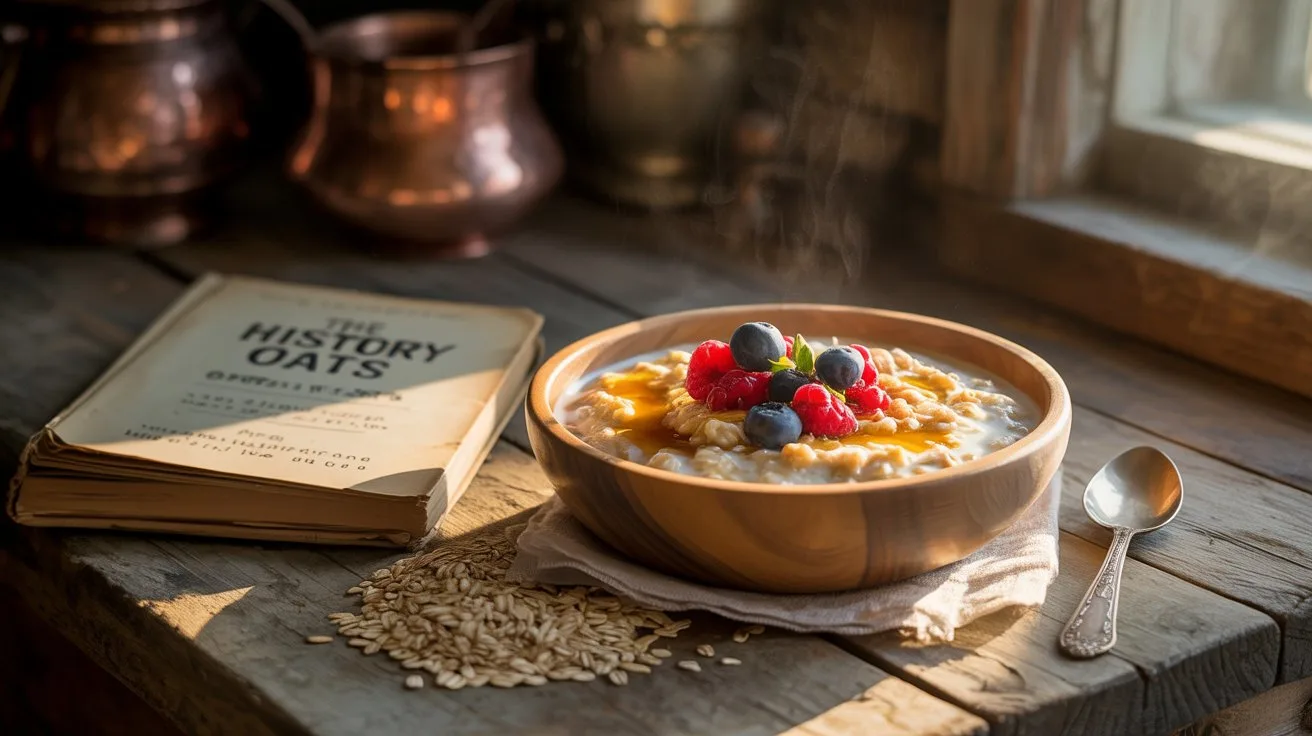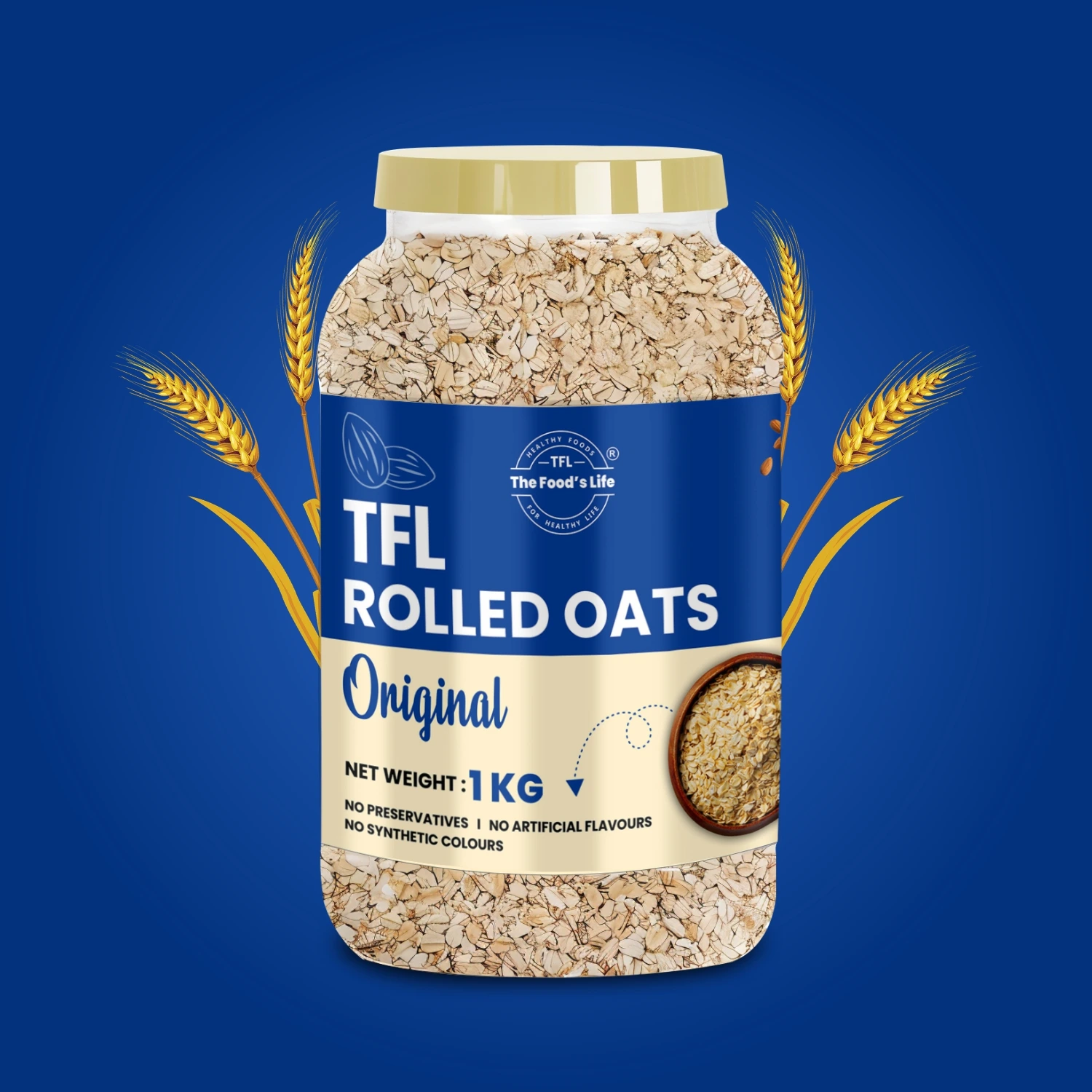Oats are one of the most resilient crops in human agriculture. They have been intertwined with civilization since ancient times. Once believed to be an insignificant crop, oats have a history that has seen it follow the route from wild grass to worldwide crop.
Initially oats were grown as an animal feed in Europe, eventually being incorporated into the human diet, especially in colder climates where grain was needed to survive the winters. Gradually, people living in cultures that consumed oats on a daily basis, such as the Scottish and Irish, transformed oats into the comfort and porridge foods we see in today's fantastic historical legacy of oatmeal and porridge.
Nutrition sciences mostly caught up in the 20th century with oat research documenting the nutritional power of oats—especially fiber, specifically beta-glucan, iron, and high-protein plant material. Oats went from a basic cereal grain to reserves by providing important everyday ingredients for heart-healthy diets, diabetic diets, and weight loss diets.
Oats are a global superfood today in all their forms: steel-cut, ground or rolled, oat milk, and flour. Now, oats literally blend both innovation and tradition everyday. Each spoonful you eat represents a history of resilience, nutrition, and wellness that make oats the polar opposite of a humble grain; it is a grain truly for all generations!
Introduction – Why Understanding the History of Oats Matters
Oats are everywhere: in breakfast bowls, smoothies, and baked goods. However, before oats were a crazy trendy superfood, they had a long, sometimes difficult, yet certainly humble journey. The history of oats spans thousands of years, illustrating how this wild grass grew its way to a global, staple diet.
When we learn about the past history of oatmeal we learn about the early societies of mankind. We also learn about oats are one of the most highly recommended grains to eat in a healthy diet by dieticians and nutritionists today.
OATS AND THERE JOURNEY FROM WILD GRASS TO GLOBAL STAPLE
Oats and Their Journey from Wild Grass to Global Staple
- The Ancient Beginning of Oats: A weed in wheat and barley fields, oats were one of the last domesticated cereal grains. Based on ancient records, oats were likely cultivated in central Europe around 1000 BC.
- Oats in Ancient Diets: Many early societies in colder climates (e.g. Scotland and Germany) relied on oats for food. In these regions, oats were much more sustainable than grains or cereals due to their ability to withstand the damp and cold weather.
- The Medieval Role of Oats: By the Middle Ages, oatmeal became one of the staple foods in northern Europe. Oatcakes and gruels were commonplace or common, hearty meals that provided tons of energy for the long cold winters.
What Makes Oats Relevant Across Centuries?
- Reliable Crop: Oats are one of the few grains that can thrive in tough soil and poorer growing environments, which makes them reliable across geography and generations.
- Digestion and Heart Health : Modern science supports what traditional eaters have known for centuries - oats help with digestion and heart health due to their fiber content, especially beta-glucan (soluble fiber), which helps lower cholesterol and regulates digestion.
- Mineral Richness : Oats are high in manganese, magnesium, iron, and vitamin B1 — and provide all-around nutritional value, which helps with energy production and immune function.
- Cultural Sturdiness: From Scottish porridge, Indian oat upma, to American oatmeal cookies, oats have a place in every kitchen. Oats are adaptable and able to age well.
The Early History of Oats in Human Agriculture
Before oats became a pantry staple and a worldwide breakfast favorite, they began their story in human agriculture in a non-glamorous, unintentional role. Let's take a look at how this once humble grain became the superfood they now are.
The Origin and Early Cultivation of Oats
Wheat and barley were among the first crops domesticated in the Fertile Crescent, but oats were definitely a late arrival to the party. The story of oats doesn't begin in a place of glamor, but rather survival.
- Origins in Europe: Initially, evidence shows that wild oats were gathering in central and eastern Europe more than 4,000 years ago. Unlike other grains, oats were able to thrive in cooler and wetter habitats where barley and wheat did poorly.
- From Weed to Food: In fact, oats were often seen as a weed in the wheat fields – it was not until farmers realized they could thrive in unfertile soils, that they were purposely sowed and cultivated.
Oats in Ancient Civilizations and the Early Human Diet
Oats may be late to the farming table but certainly made an important impact on the diet in Northern Europe.
- Celtic and Germanic Tribes: Celtic and Germanic tribes were known to regularly consume oats as a satisfying hot meal, especially oatmeal porridge or flat oat cakes. Satisfying and sustaining calorie and nutrition on cold winter days.
- A Grain for the Common Folk: Roman societies preferred wheat and dismissed oats as animal feed, but groups in Scotland, and Scandinavian cultures embraced oat for being digestible and nutritionally dense.
- History of Oatmeal: The history of oatmeal starts here where gruels or porridge were likely the essential components of simple, nutritious meals. Gruels and porridge were the original oatmeal dishes that helped pave the way for today’s delicious and healthy oat based creations.
How Wild Oats Became a Farmed Crop
As agricultural methods developed and spread, farmers began to realize what oats were capable of: principally:
- Adaptability: Oats adapted well to different fields and grew with little investment. In uncooperative climate, as a grain, they are safe, hardy and resistant to farm disease; correct soil and they are reliable.
- Nutritional Power: Ancient societies, although not privy to the science, knew the benefits— oaten grains gave them energy, kept them full for extended periods and kept them healthy through the seasons. These were some of the earliest indications of the benefits of oats.
- Transition to a Cultivated Crop: By the Iron Age, oats had evolved to a recognized and cultivated food crop. When climatic conditions were not suitable to grow fancier grains, oats began to take its place before becoming widespread across the British Isles, nations of northern France and Sweden.
History of Oatmeal in European and Global Diets
It was the evolution of oatmeal – plain, cheap, nourishing, and easy-to-make – that established oats as part of the diets people used all over the world. Oatmeal has a long and rich historical, cultural, and culinary history.
Medieval Oat Farming and Traditional Oatmeal Dishes
During the Middle Ages, oat farming developed well in northern climates that were cool and wet, and especially in places where wheat and barley struggled.
- Ideal for Northern Climates:Countries such as Scotland, Ireland, and Northern Europe had dry and cool climates that were perfect for their favorite style of oats.
- Simple Yet Powerful Meals:Farmers, laborers, or families often started their day with a bowl of oatmeal porridge or oat porridge. cooked oats added was a dish cooked in boiling water or milk. which is a solid source of energy support and was an inexpensive, enough meal!
- Versatile Ingredient:Typically, oats were also baked flatbreads or boiled into broths. this cooking model made oats a staple in peasant food throughout medieval Europe.
The Role of Oatmeal in Scottish and Irish Culture
The heritage of oats is the deepest and most significant in the heart of Celtic culture in Scotland and Ireland where oats were more than simply food; they were a way of life.
- Scotland's National Grain: Too little warmth for wheat, Scots turned to oats. Scots porridge became a national dish prepared with salt and stirred with a traditional wooden spurtle.
- Daily Fuel: Highland Scots, carrying pouches of oatmeal on long journeys, would simply mix oatmeal with water to make an instant porridge. A very early portable food source, or early stages of portable energy food .
- Cultural Rituals: Oatcakes were served at weddings and births as well as to celebrate the harvest to promote sharing good fortune and happiness.
- In Ireland: Oats were grown and eaten extensively, and frequently consumed with buttermilk. Every Irish household had their own recipes for oatmeal and shared many stories with one another about how they brewed the oatmeal, sometimes adding dried fruits or honey for a festive twist.
The Evolution of Oatmeal History Through Trade and Empire
As European powers started to grow their realms of influence around the globe, their cereals—especially oats—were part of this process.
- Oats in the Americas: When European settlers moved to North America, they brought the oats that they were familiar with, which eventually adapted to the soils in the new land. Oatmeal gained traction in the U.S. in the late 19th century, growing most popular in states with colder climates.
- Industrial Revolution & Oat Processing: The products developed in the 19th century of rolled oats and instant oats, changed the nature of oats and oatmeal into breakfast foods that would saturate the global morning menu. Moving forward with the time, we progressed along the timeline of the story of oatmeal, and packaging it was an essential step was a great step in making oatmeal instantaneous.
- Global Consumption: Now, oats can be found as oats in muesli in Germany, oat drinks in Asia, and granola in the U.S. The journey of oats from when they were utilized as a porridge in the medieval era to now being regarded as a global superfood is the tale of evolution and harnessing timeless energy and nourishment.
From Livestock Feed to Everyday Food: A Turning Point in the History of Oats
While oats are referred to as a superfood today, they have not always enjoyed this level of prestige. For centuries, oats were recognized more as livestock feed than as anything we might feed to humans. However, with our growing understanding of oats benefits, oats began to find their way to our tables, and ultimately, into the diets of people who pay attention to what they eat across the world.
Oats as Animal Feed in Early Farming
Before scientists recently discovered the benefits of oats, oats were grown primarily as animal feed, particularly for their strength and stamina in horses, and cows and other livestock.
- Durable and Easy to Grow: Oats can grow in marginal soil and wet climates, making them an inexpensive crop for farmers.
- Staple for Working Animals: Horses, especially in a European farming or army setting, were often fed oats for their stamina and strength.
- Farm Feed: Oats would often be made into mash or hay for cows and sheep in particular regions, resulting in farmers getting the most out of their oat crop.
The Shift to Human Consumption
Over the years, especially during population booms and food shortages, oats started to become more common on people’s plates.
- Necessity During Hard Times: During famines and wars, oats (that were once only used to feed animals) became a useful grain for human survival.
- Rural Peasant Diets: Communities in Northern Europe turned to oatmeal porridge when wheat was too expensive or was no longer available.
- Accessibility: Mill advancements developed rolled oats and made cooking faster, which brought oats into everyday households.
Discovery of Oats Benefits and Nutritional Value
The real change occurred when science corroborated tradition and demonstrated the extraordinary benefit of oats for human health..
- High in Soluble Fiber: The 20th century brought studies on the cholesterol-lowering effect of beta-glucan, a soluble fiber found in high concentrations in oats.
- Rich in Plant-Based Protein: Oats providing about 13 grams of protein per 100g, promotes muscle healing and supply essential nutrition for moderate dietary consumption of oats as a plant-based protein source.
- Supports Heart and Gut Health: The history of oatmeal took a turn Dramatically when evidence emerged that oats were good for digestion and weight loss when included in a regular diet, indicating they were functional foods. The last major discovery of the health benefits of oats demonstrated that oats had the potential of improving degenerative diseases such as diabetes.
- Whole Grain Goodness: With B vitamins, iron, and antioxidants, the recommendation that oats be transitioned as "feed grains" to functional food positioned oats in the health movement, with the realization of another whole grain food.
The Rise of Oats in Modern Health and Wellness Culture
The history of oats took a major turn in the twentieth century when studies were published discussing the health advantages of oats, and oats became a much more recognized grain. Oats received a boost from survival food in rural Europe to become a highly regarded superfood in kitchens and pantries around the world, and even a status symbol in certain cultures.
20th-Century Research and the Oats Revolution
Oats were being consumed primarily as porridge meals and part of the typical meal in the early 1900s. Then, researchers and medical professionals began reporting the additional health benefits of consuming oats.
- Scientific Validation of Oats Benefits: Dietary studies in the early 1980s showed that beta-glucan from oats was showing a link to improve beta-glucan from oats was showing a link to improve ldl cholesterol levels, better regulation of blood glucose, fewer appetite cravings, and decreased fat mass.
- Nutritional Profile in Focus: Along with oats being recognized for total carbohydrates, the sugar, protein, fiber, as well as potassium, calcium, magnesium, phosphorus, and iron. Most people can agree, the story of oatmeal has finally developed into an attractive food and become the centerpiece program.
- Oats in Clinical Diets: For example, medical professionals started recommending oats under behavioral nutrition plans, for adults with high cholesterol issues, coronary heart disease, and even individuals with digestive issues.
The Rise of Oats in Heart Health and Cholesterol Management
The emergence of oats as an important component of dietary prevention strategies came at an ideal time, as cardiovascular disease assumed a prominent position on global agendas. More importantly, oats were a well-established health food, with documented efficacy in several public health domains, including cardiovascular disease prevention, weight loss management and glycemic control.
- Oats for Heart Health: The beta-glucan in oats maintains the health of our arteries while modulating the pro-inflammation markers associated with cardiovascular disease.
- Oats in Medical Guidelines: Several national health authorities also included oats in their clinical guidelines for managing blood cholesterol and overall heart health.
- Shift to Functional Foods: Oats were now viewed as 'functional foods', which move beyond the basic definition of food to food with potential health benefits.
Modern Forms: Oat Milk, Granola, Oat Flour, and More
In today's food culture, oats have become one of the most popular ingredients and can be found in a diverse range of innovative products.
- Oat Milk: Oat milk is a dairy-free option that has recently gained a lot of popularity since it can mimic the consistency of dairy milk, and is heart-healthy, easier on your stomach, and eco-conscious.
- Granola and Energy Bars: Granola produced from whole oats is a common breakfast choice and has become a staple snack on-the-go. When oats are combined with nuts and fruits, it will provide sustained energy and make you feel full longer.
- Oat Flour: The gluten-free baking craze has welcomed oat flour because of its mild flavor along with great fiber content. Oat flour is a good replacement for refined flours when making breads, muffins, or pancakes.
- Oats in Vegan and Fitness Recipes: Oats are now being used in a wide variety of recipes from protein balls to smoothie muffins, taking advantage of oats benefits from athletes to fitness lovers and plant based eaters.
Oats Benefits That Have Stood the Test of Time
Throughout history and across civilizations, oats' story is as much about their survival as a crop as their enduring importance to human diets. Oats are great sources of nutrition from ancient fields to contemporary breakfast bowls.
Rich in Fiber, Iron, and Heart-Healthy Beta-Glucan
One of the long-lasting oats benefits is their high floors of dietary fiber and beta-glucan, a soluble fiber recognized for its important role in heart health.
- Fiber for Digestion and Satiety: Oats can help your digestion to keep you regular and feed healthy gut flora. Because of oats' soluble and fermentable fiber, they also help to keep fullness, so they assist with your weight management as well.
- Iron for Vitality: Oatmeal in traditional diets from cultures around the world was used often to improve energy levels and to ameliorate iron shortages, especially in communities that had lean beef access.
- Beta-Glucan’s Cardiovascular Role: Way before we identified beta-glucan, our pre-industrial diets included oats in heart-healthy meals. We know now that oats and beta-glucan can decrease LDL cholesterol and keep blood sugar steady, which highlights the role oats can play as part of a heart healthy diet.
Gluten-Free, Diabetic-Friendly, and Sustainable
The history of oats has advanced them into a position compatible with contemporary diet considerations.
- Gluten-Free Alternative: Oats are naturally gluten-free and offer a good alternative for those with either celiac disease or gluten intolerance (as long as they are processed in gluten-free facilities).
- Oats for Diabetes Management: Oats have a low glycemic index, meaning they release sugar into the bloodstream slowly and allow people with diabetes or predisposed for diabetes to better manage an insulin response with slower and lower blood sugar.
- Environmental Sustainability: Oats are a low impact crop, needing less water and fertilizer than many other grains. Oats are hardy and adaptable, making them a sustainable food option which is helpful when considering the impact on climate.
Oats in the Global Food Landscape Today
As one of the oldest cultivated crops and now part of the modern superfood trend, oats are still evolving as a food ingredient to meet the world's growing recognition of their versatility and healthfulness. Oats are no longer just a breakfast grain; they are now a versatile kitchen staple across sectors and cultures.
Innovative Oat Products in Modern Cuisine
Today's food world is abuzz with oat-related innovation including:
- Beyond Breakfast: The story of oats begins with simple porridge, but today oats are used in oat-based pasta, oat burgers, oat energy bites, and even oat milk based ice creams.
- Oat Milk Boom: The popularity of oat milk has arisen as one of the most significant developments in plant based diets, boasting a creamy texture with a lower environmental footprint. Oat milk is a major staple for vegan diets and coffee shops alike.
- Oat Flour in Baking: Oat flour is gluten free and a more nutritious alternative to many highly refined flours, becoming a staple for healthy baked goods from pancakes to pizza crust.
Oats in Beauty, Nutrition, and Wellness Industries
Oats have moved beyond the kitchen and are now being incorporated into health and personal care roles.
- Skincare Applications: Due to their soothing characteristics, oats can be used in lotions/potions, masks, bath additives, and bath treatments to treat irritation and hydrate dry/sensitive skin.
- Nutraceutical and Supplement Use: Components of oats (avenanthramides, and the soluble fiber beta-glucan) have been extracted from oats for use in supplements to promote heart health and modulate cholesterol levels.
- Fitness and Sports Nutrition: Oats are valued in the fitness and sports nutrition community for their slow-release carbohydrates and oat protein. As such, oats feature prominently in protein bars, shakes, and meal replacements.
The Future of Oats in Sustainable Agriculture
The evolution of oats has always been associated with their ability to germinate even in harsh conditions, and today this trait positions oats as a leading sustainable grain, or crop, for farmers.
- Low Input, High Yield: Oats require less water, fewer chemical inputs, and prefer to grow under cooler temperatures; therefore, oats can be categorized as an environmentally responsible crop.
- Crop Rotation and Soil Health: Oats attract positive soil biological activity, structure, and soil fertility. When oats are used in rotation with other crops, your farm will continue to be productive farm after farm.
- Meeting Global Health Goals: Plant-based diets and lower impact diets are on the rise in society, and oats can be part of a nutrient-dense solution to feeding populations and producing lower environmental impacts.
FAQs
Q1 What is the origin of oats?
The history of oats dates back to ancient Europe when they were created as a robust cereal grain.
Q2 What is the history of oatmeal in traditional diets?
Oatmeal has a long history rooted in Scottish and Irish cuisine as a basic comfort food.
Q3 Why did oats transition from livestock feed to human food?
Oats switch to human food began because studies identified benefits including heart health and high fiber.
Q4 Are oats gluten-free and safe for everyone?
Yes, oats are gluten-free. Safe for most people unless they get cross contaminated in processing.
Q5 What makes oats a superfood today?
Oats benefits include beta-glucan for cholesterol control, the high fiber content for digestion, and sustained energy release.
Conclusion – Embrace the Legacy and Power of Oats
A Grain Rooted in Tradition and Grown for the Future
The historical journey of oats began thousands of years ago, when oats were nothing but a grass and continued throughout various time periods such as ancient and medieval times, in which oats were an important source of nutrition. Oats have evolved and adapted with the ups and downs of humanity, and they continue to provide food during the highs and lows. Today, oats are an important part of traditional recipes and modern day health trends.
Why the History of Oats Makes Them More Than Just Food
Examining the history of oatmeal and attesting to its meaningful cultural history is worthwhile. From the porridge pots held by kitchens of Scots, to the meteoric and rapid rise of oatmeal as a superfood, it has frequently been regarded for its versatility and durability. And these characteristics underline the significant oats benefits that have remained unchanged through time, such as supporting heart health, providing digestion support, and acting as long-term energy.
Add Oats to Your Daily Routine—For Heritage, Health, and Happiness
When you choose oats as a food source, it is more than a choice, it is nearly a connection to generations and generations of nutritional wisdom. Whether it is in the form of a warm bowl of oatmeal, a healthy baked good, or a hip oat milk latte, oats have a restorative balance of being traditional as healthful food. Whole oats can be a part of your everyday experience, not only to add perspective to a cultural heritage, but to help create meaningful, and long-term health.






